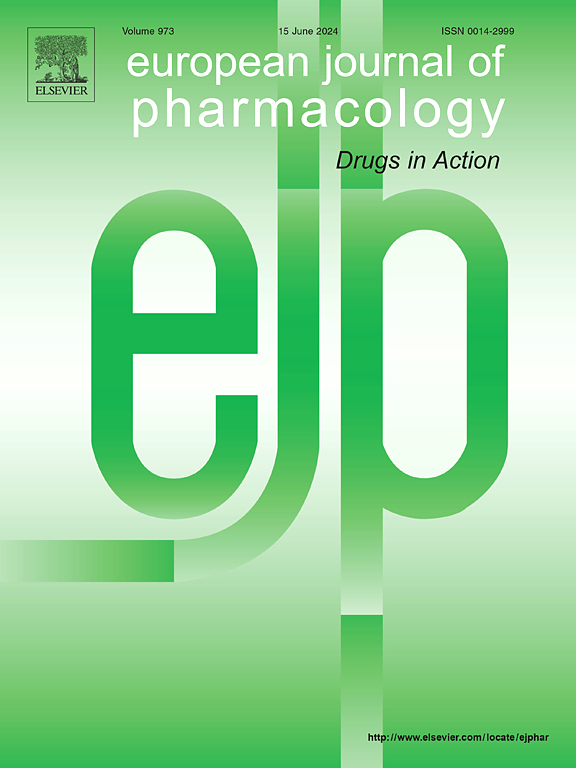Transforming Growth Factor-β-mediated attenuation of cardio-renal oxidative stress, inflammation and fibrosis by L-arginine in fludrocortisone acetate induced-hypertensive rats
IF 4.2
3区 医学
Q1 PHARMACOLOGY & PHARMACY
引用次数: 0
Abstract
Uncontrolled hypertension is a primary contributor to tissue damage in multiple organs, including the heart and kidneys. In this study, we explored the protective roles of L-arginine in a mineralocorticoid-induced rat model of hypertension. To induce hypertension and subsequent organ damage, rats were nephrectomized unilaterally and fed with the mineralocorticoid fludrocortisone acetate and dietary salt (FCA-Salt). These rats were treated with L-arginine for 28 days, and subsequent tests were performed. Biochemical analysis revealed the increased level of inflammation and oxidative stress biomarkers in the plasma, heart, and kidney of the FCA-salt-treated rats. L-arginine treatment decreased the oxidative stress marker malondialdehyde (MDA) by 18 %, 22 %, and 18 % in the heart, kidney, and plasma, respectively. L-arginine also attenuated the advanced oxidative protein products (AOPP). The activity of superoxide dismutase (SOD) increased by 62 %, 45 %, and 16 % in the heart, kidney, and plasma, respectively, in the L-arginine-treated animals compared to the FCA-Salt group. Significant augmentation was also revealed for the nitric oxide (NO), catalase (CAT), and reduced glutathione (GSH). The plasma levels of the kidney function biomarkers uric acid and creatinine were significantly improved after L-arginine treatment. Furthermore, L-arginine remarkably reduced the elevated plasma cytokines IL-1β, IL-17A, TNF-α, and TGF-β1 in FCA-salt-induced hypertensive rats. Histopathological data showed a reduction in fibrosis and tissue damage by L-arginine in the FCA-salt-treated group. We propose that L-arginine could be an effective agent in preventing cardiac and renal dysfunction in hypertensive rats.

不受控制的高血压是造成包括心脏和肾脏在内的多个器官组织损伤的主要原因。在这项研究中,我们探讨了 L-精氨酸在矿物皮质激素诱导的高血压大鼠模型中的保护作用。为了诱导高血压和随后的器官损伤,我们对大鼠进行了单侧肾切除,并喂食了醋酸氟氢可的松和食盐(FCA-Salt)。这些大鼠接受了 28 天的 L-精氨酸治疗,并进行了后续测试。生化分析表明,经 FCA 盐处理的大鼠血浆、心脏和肾脏中的炎症和氧化应激生物标志物水平升高。左旋精氨酸治疗使心脏、肾脏和血浆中的氧化应激标志物丙二醛(MDA)分别降低了 18%、22% 和 18%。左旋精氨酸还减少了高级氧化蛋白产物(AOPP)。与 FCA 盐组相比,L-精氨酸处理组动物心脏、肾脏和血浆中的超氧化物歧化酶(SOD)活性分别增加了 62%、45% 和 16%。一氧化氮(NO)、过氧化氢酶(CAT)和还原型谷胱甘肽(GSH)的含量也显著增加。左旋精氨酸治疗后,肾功能生物标志物尿酸和肌酐的血浆水平明显改善。此外,L-精氨酸还能明显降低 FCA 盐诱导的高血压大鼠血浆中升高的细胞因子 IL-1β、IL-17A、TNF-α 和 TGF-β1。组织病理学数据显示,L-精氨酸可减少 FCA 盐处理组的纤维化和组织损伤。我们认为,L-精氨酸可有效预防高血压大鼠的心脏和肾脏功能障碍。
本文章由计算机程序翻译,如有差异,请以英文原文为准。
求助全文
约1分钟内获得全文
求助全文
来源期刊
CiteScore
9.00
自引率
0.00%
发文量
572
审稿时长
34 days
期刊介绍:
The European Journal of Pharmacology publishes research papers covering all aspects of experimental pharmacology with focus on the mechanism of action of structurally identified compounds affecting biological systems.
The scope includes:
Behavioural pharmacology
Neuropharmacology and analgesia
Cardiovascular pharmacology
Pulmonary, gastrointestinal and urogenital pharmacology
Endocrine pharmacology
Immunopharmacology and inflammation
Molecular and cellular pharmacology
Regenerative pharmacology
Biologicals and biotherapeutics
Translational pharmacology
Nutriceutical pharmacology.

 求助内容:
求助内容: 应助结果提醒方式:
应助结果提醒方式:


